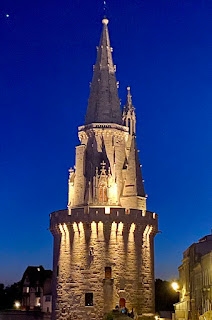Our hotel the next morning in the sunshine.
The St. Malo wall.
Ditto.
Old town St. Malo from across the port, with a good view of the southern side of the walls and with the cathedral tower rising above all other buildings.
Ditto.
A piece of Roman wall.
A battle-scarred machine gun emplacement.
Tower in St. Malo.
The beach.
St. Malo is famous for the layered, buttery pastry known as Kouign Amann. We bought a package of miniatures to share with the group on the upcoming bus ride.
We rode the FlixBus from St. Malo to La Rochelle. It was a very smooth ride departing at 2:00 pm, had three stops (Rennes, Nantes and a bus stop with facilities) and arrived in La Rochelle at 7:30 pm. We had about a 20 minute walk to our hotel (Maisons du Monde) in the Old Port. La Rochelle on a summer Sunday evening was packed with people enjoying the sea breezes and tourist facilities. It seems to be a small gem of a city.
We quickly went out for dinner next door to the very excellent Restaurant Andre.
Moules (mussels) was a particular popular dinner choice. Seafood is a speciality of the area. We happen to be on a street known to the locals as "Restaurant Street."
The Lantern Tower (historically a lighthouse illuminated by bonfires), one of three towers along the only short section of city walls still in existence, in La Rochelle, at night.
The same tower in the morning during our free guided walk.
Our guide, John, who is originally from Northern Ireland, gave us a comprehensive overview of the history of La Rochelle and took us to about 8 spots around town over 2 hours. La Rochelle was part of the principality of Aquitaine, headed by Eleanor of Aquitaine (who married both the King of France and the King of England). As a result the city had many privileges and rights not accorded to many other French Cities. It was a stronghold of French Protestants who were a persecuted minority in Roman Catholic France. In 1628, Cardinal Richelieu decided the city needed to be taken under control. The city already had a defensive wall and control over port access, but Richelieu caused a second wall and dam across the harbor to be built and set out to besiege the city. It took 18 months and the death or departure of 20,000 inhabitants before the city conceded. Other points of interest: The city now imports furniture-quality wood from American and exports grains to China. It has a mild climate and as many sunny days as Mediterranean resorts. During WWII, the Germans maintained a shipyard for assembling UBoats. In addition to a thorough tour of the historic city, we were treated to a tasting of the local Cognac and aperitif wines - very tasty. Our guide said he lives in La Rochelle because it's where he met his French wife and has 3 children (who happen to have 3 nationalities - British, Irish and French).
The Big Clock Tower.
A 3' by 3' bronze sculpture where each column of faces represents knowledge that is passed "up" to the next generation through an open book, but if the book closes, the future generations fall apart and disintegrate.
Note the surprising cat figure on the roof - no one knows how it came to be there.
The City Hall - the oldest city hall in Europe still in use.
The St Nicholas and Chain Towers - they are at the entrance to the inner port and historically a chain was stretched between the towers to control access to the inner harbor. Ships had to leave behind their cannons before entering the port and pay a tax before the chain was lifted so they could leave.
The Big Clock Tower.
Jan with John, our guide.
Lunch at The Panier des Crabbes, a sailor's bar which delivered our individual orders on a single large plate of seafood (on the raised rack). Ron, Jan and I tucking into the big prawns, brown crab, little gray shrimp, and whelk. Our tour guide recommended the restaurant but warned us service was available only between noon and two pm
An example of the seafood plate.
After lunch, Jan, Ron, Betsy and I walked to the WWI memorial (below) since Jan's grandfather was stationed at La Rochelle. We passed by a number of the prestigious homes including this unique one.
The World War I memorial to the local men who were lost.


























Pass the seafood please. It looks delicious. Great architecture!!!
ReplyDeleteCw
DeleteWow, the seafood! And the sights!
ReplyDeleteI have Huegonot ancestors. I have often wondered it they ever lived in New Rochelle. Sounds like a nice place. Cg
ReplyDelete